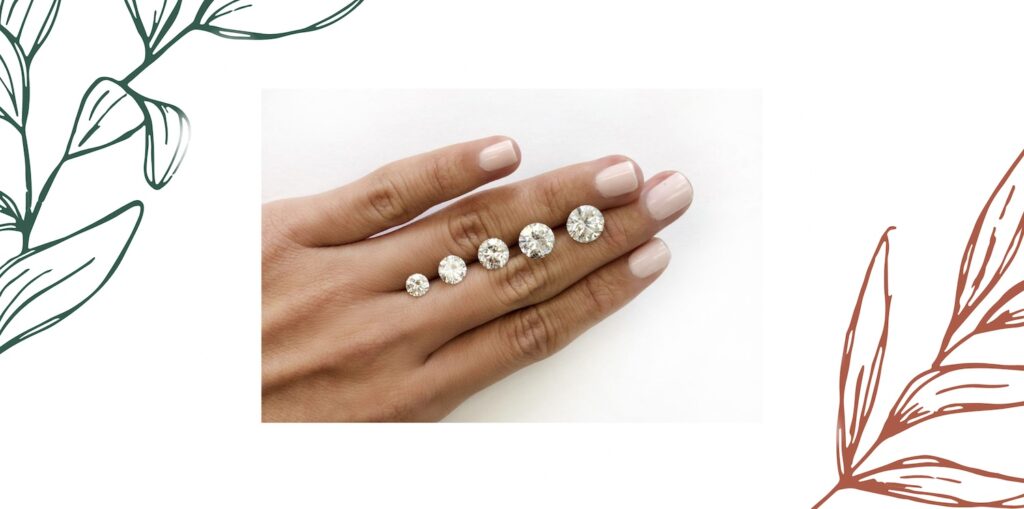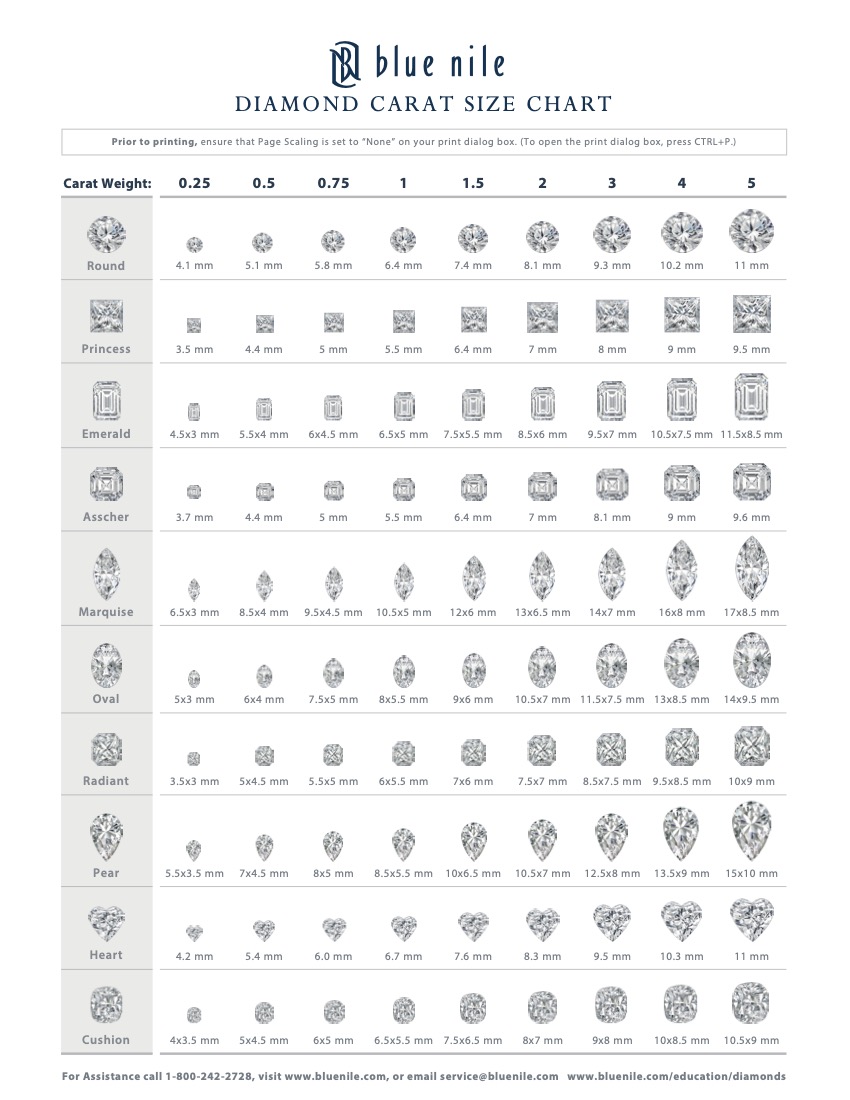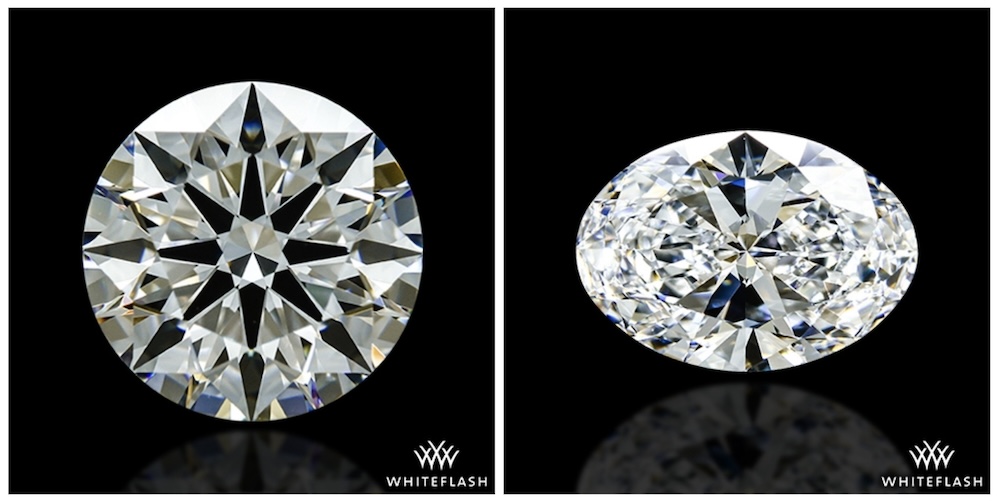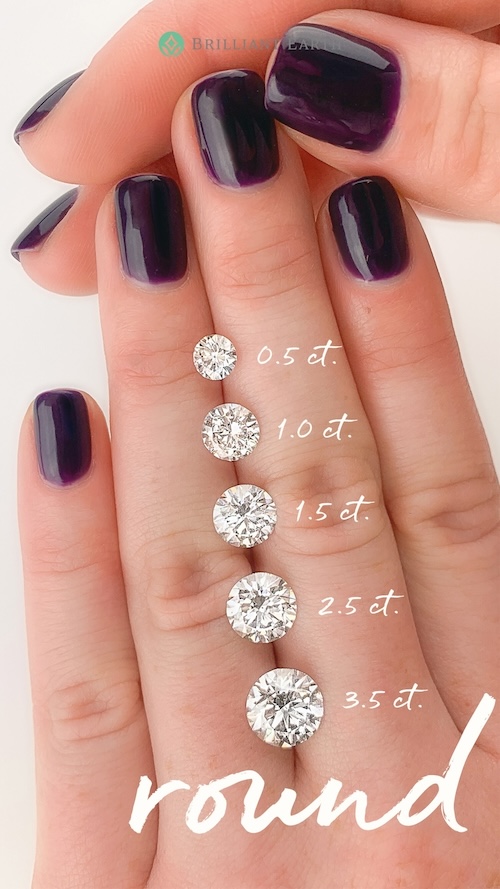©2024 Lab Diamonds Reviews – All Right Reserved.
Education
Diamond Size

This article has mentions of products from one or more companies, and I may receive compensation if you purchase those products following reading my recommendations.
When it comes to selecting the perfect diamond, size certainly matters. It’s a feature that captures attention, symbolizes value, and plays a significant role in the aesthetic appeal of a piece of jewelry.
What's In This Guide
ToggleHowever, choosing the right diamond size is more than just opting for the largest stone within your budget. It’s about understanding how size interacts with other factors like shape, quality, and, importantly, the proportions of the wearer’s hand. In this article, we’ll delve into the world of diamond sizes, exploring popular trends, backed by facts and figures, and provide insights on the best diamond sizes for specific finger types.
Whether you’re choosing an engagement ring, a special gift, or a treat for yourself, this guide will help you make an informed decision.

The Basics of Diamond Size
Understanding Carat Weight vs. Dimensions:
- Carat Weight: Refers to the weight of the diamond, not its size. One carat equals 200 milligrams.
- Dimensions: The actual size of the diamond as it appears when viewed from above. This is influenced by the diamond’s cut and shape.
Size and Appearance:
- The perceived size of a diamond can vary significantly depending on its shape and cut quality. For example, a marquise or oval diamond may appear larger than a round diamond of the same carat weight due to its elongated shape.
- The cut quality can also impact how large a diamond appears; a well-cut diamond will often appear larger than a poorly cut diamond of the same carat weight.

Comparative Image of a Round and Oval Diamond: Both diamonds have identical carat weights, yet exhibit distinct dimensions. The round diamond measures 6.44×6.46×3.97 mm, showcasing a more compact form, while the oval diamond, at 8.13×5.72×3.53 mm, presents a more elongated and slender appearance, illustrating how shape influences perceived size and dimensions.
Size and Price:
- Diamond prices increase exponentially with carat weight. This is because larger diamonds are rarer and more desirable.
- According to the Rapaport Diamond Report, a highly respected pricing resource, the price of a diamond can jump significantly at certain popular carat weights, such as 1 carat, 1.5 carats, and 2 carats.
Popular Sizes and Trends:
- The most popular diamond size for engagement rings is around 1 carat. This size offers a balance between noticeable size and affordability.
- Trends can vary by region and culture. For instance, in the United States, the average engagement ring diamond size is typically between 1.08 to 1.2 carats, as reported by The Knot’s Real Weddings Study.
- Smaller diamonds, ranging from 0.5 to 0.75 carats, are often chosen for their affordability and for more understated jewelry pieces.
Seeking the best quality lab diamonds? Whiteflash’s Precision Lab is your answer, offering diamonds of unparalleled brilliance and precision. For a journey into ethical and pioneering lab diamonds, turn to Brilliant Earth’s exquisite collection. And if variety is what you desire, James Allen’s extensive selection awaits to match your unique style. Embark on your quest for the perfect diamond today!
Popular Diamond Sizes – Trends and Facts
Understanding the trends and preferences in diamond sizes can help you make a more informed choice. Here’s a look at what’s popular and why:
Engagement Rings:
- Average Sizes: As per a report by The Knot, the average diamond size for engagement rings in the U.S. is between 1.08 to 1.2 carats.
- Regional Variations: In metropolitan areas or affluent regions, the average size tends to be higher, often around 1.5 carats.
Global Trends:
- International Differences: In countries like the UK and Australia, the average size is slightly smaller, typically around 0.6 to 0.8 carats.
- Cultural Influences: Cultural factors and economic conditions significantly influence average sizes in different regions.
Size vs. Quality:
- Consumer Preferences: Many buyers prefer to invest in a higher quality diamond (better cut, color, and clarity) over a larger size with lower quality.
- Industry Insights: Jewelers often suggest prioritizing quality and cut over size for better long-term value and appearance.
Diamond Size and Finger Proportions
Choosing a diamond that complements the wearer’s finger size and shape is crucial. Here are some guidelines:

Progressive Display of Diamond Sizes on a Hand: Showcasing diamonds ranging from 0.5 to 3.5 carats, this image illustrates the gradual increase in size and visual impact of diamonds from a delicate 0.5 carat up to a striking 3.5 carat, providing a clear perspective on how different carat weights appear when worn.’
Small Fingers:
- Ideal Sizes: For slender fingers, diamonds up to 1 carat can create an elegant and proportionate look.
- Shape Considerations: Elongated shapes like oval, marquise, or pear can make the finger appear longer.
Medium Fingers:
- Versatility: Medium-sized fingers can carry a wide range of diamond sizes well, from 1 to 1.5 carats being a popular choice.
- Shape Flexibility: Both round and fancy shapes generally look proportionate on medium fingers.
Large Fingers:
- Larger Diamonds: Fingers that are wider may benefit from diamonds over 1.5 carats to create a balanced look.
- Bold Shapes: Shapes like radiant, cushion, or Asscher can appear more proportionate on larger fingers.
General Tips:
- Personal Preference: Ultimately, personal style and preference should guide the choice.
- Try-On: It’s always recommended to try on different sizes and shapes to see what looks and feels best.
Begin your diamond adventure with James Allen’s expansive collection, where variety meets quality. For those who prioritize ethical sourcing and innovation, Brilliant Earth offers a range of stunning lab-grown diamonds. And for unparalleled quality, Whiteflash’s Precision Lab diamonds are a testament to excellence. Choose your ideal diamond today!
The Impact of Diamond Shape on Perceived Size
The shape of a diamond can significantly influence how large it appears. Understanding this can help in selecting a diamond that meets size expectations within a certain budget:
Perception of Size by Shape:
- Elongated Shapes: Diamonds with elongated shapes like oval, marquise, and pear often appear larger than round diamonds of the same carat weight due to their larger surface area.
- Square Shapes: Conversely, square shapes like princess and cushion cuts may appear smaller than round diamonds of similar weight because of their more compact surface area.
Shape and Finger Proportions:
- Complementing Finger Shape: Certain diamond shapes can complement the wearer’s finger shape better. For example, elongated diamonds can make short fingers appear longer.
- Visual Illusions: A well-chosen diamond shape can create flattering visual illusions, enhancing the overall appearance of the hand.
Balancing Size with Other Diamond Qualities
While size is a significant factor, it’s important to balance it with other diamond qualities for the best overall value and appearance:
The 4Cs Balance:
- Cut: A well-cut diamond will exhibit more brilliance and can appear larger.
- Color and Clarity: Sometimes, compromising slightly on color and clarity can allow for a larger size within the same budget.
- Carat: Remember that doubling the carat weight doesn’t double the diameter of the diamond, but it can significantly increase the price.
Budget Considerations:
- Cost vs. Size: Larger diamonds exponentially increase in price. It’s often more budget-friendly to choose a slightly smaller diamond with better cut and clarity.
- Long-Term Value: Consider the long-term value and wearability of the diamond, not just the initial appeal of its size.
Personal Preferences and Lifestyle:
- Lifestyle Considerations: Think about how the diamond will fit into the wearer’s daily life. Larger diamonds might not be practical for someone with a very active lifestyle.
- Style Preferences: The choice should also reflect the wearer’s personal style. Some may prefer a larger, more noticeable diamond, while others might opt for subtlety and elegance.
Recommendations for Specific Finger Sizes
Selecting the right diamond size for specific finger sizes is crucial for achieving a harmonious and aesthetically pleasing look. Here are some tailored recommendations:
- For Small Fingers: Diamonds up to 1 carat tend to complement slender fingers well, maintaining elegance without overwhelming the hand. Elongated shapes like oval or pear can also create a lengthening effect on the finger.
- For Medium Fingers: Medium-sized fingers offer versatility, accommodating a wide range of sizes. Diamonds between 1 to 1.5 carats are often a popular choice, providing a balanced and proportionate appearance. Both round and fancy shapes work well.
- For Large Fingers: Larger fingers may benefit from diamonds over 1.5 carats to create a balanced look. Bold shapes like radiant, cushion, or Asscher cuts can appear more proportionate and striking on larger fingers.
Conclusion:
Choosing the right diamond size is a blend of art and science, balancing aesthetic appeal with practical considerations. While trends and popular sizes provide a guideline, the final choice should align with personal style, finger size, and budget. Remember, a diamond’s beauty is not solely in its size but in how it complements the wearer and captures their unique essence. Whether you opt for a dainty 0.5-carat stone or a bold 2-carat showstopper, the right diamond is the one that feels right for you. We encourage you to explore various sizes and shapes, considering not just the immediate appeal but also how the diamond fits into your lifestyle and personal style narrative.
Step into the world of sustainable luxury with Brilliant Earth’s pioneering lab diamonds. For a selection that combines quality with variety, James Allen is your destination. And when only the best will do, Whiteflash’s Precision Lab offers diamonds of unmatched quality and brilliance. Find your perfect diamond match now!
